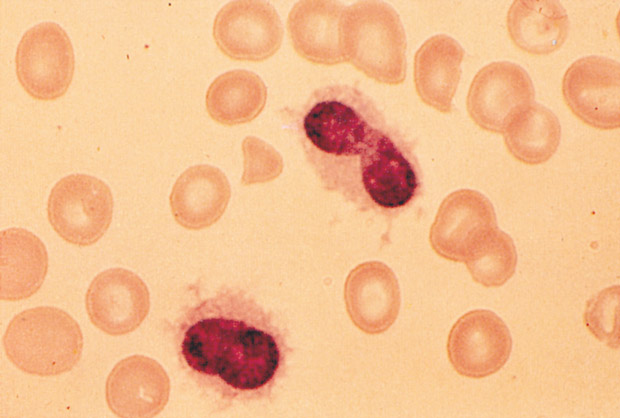MKSAP Quiz: Fatigue, anemia for 2 months
A 67-year-old man is evaluated for fatigue and anemia of approximately 2 months' duration. He has no other symptoms and takes no medications.
On physical examination, vital signs are normal. Petechiae are noted on the lower extremities, and there is conjunctival pallor. The spleen is palpable 4 cm below the costal margin. There is no lymphadenopathy and no hepatomegaly.
Laboratory studies:
| Hemoglobin | 10.4 g/dL (104 g/L) |
| Leukocyte count | 2,200/µL (2.2 × 109/L) with 63% lymphocytes, 34% segmented neutrophils, 3% monocytes |
| Platelet count | 73,000/µL (73 × 109/L) |
Flow cytometry of peripheral blood confirms kappa-restricted CD20+ B cells expressing CD11c, CD25, and CD103.

Peripheral blood smear is shown.
Which of the following is the most appropriate treatment?
A. Cladribine
B. Interferon alfa
C. Rituximab
D. Splenectomy
E. Observation
Answer and critique
The correct answer is A. Cladribine. This item is Question 119 in MKSAP 18's Hematology and Oncology section.
This patient has hairy cell leukemia, a low-grade B-cell disorder characterized by cytopenia and splenomegaly without lymphadenopathy. Hairy cells (classic appearance of thread-like projections emanating from the cell surface) are typically seen in the peripheral blood smear, and findings on flow cytometry demonstrate positivity for surface markers CD20, CD11c, CD25, and CD103. Cladribine is an appropriate initial therapy for hairy cell leukemia. Cladribine, as well as another purine nucleoside analogue, pentostatin, is associated with complete response rates exceeding 80% to 90%. A single 5- or 7-day course of cladribine is often all that is required. Many patients have durable remissions, although a significant minority do relapse and require retreatment with the same or alternate agents.
Interferon-alfa therapy is active in the treatment of hairy cell leukemia but is rarely used anymore given its toxicity and inferior response rate compared to other agents.
Hairy cell leukemia is typically CD20 positive and should respond to rituximab. However, clinical trials of rituximab have shown mixed results. Many experts reserve rituximab for patients failing two cycles of a purine nucleoside analogue. Rituximab is not given as initial therapy.
Hypersplenism in hairy cell leukemia may play a larger role in the mechanism of cytopenias compared to other lymphoproliferative disorders. Splenectomy can be an effective treatment for relieving symptoms and ameliorating cytopenias associated with hairy cell leukemia. Before effective systemic therapies were available, splenectomy was the initial treatment of choice. However, splenectomy does not treat the underlying marrow infiltration and is no longer considered appropriate initial therapy.
Some patients with hairy cell leukemia are asymptomatic and do not require immediate therapy. However, this patient has fatigue and anemia, so observation would not be appropriate.
Key Point
- Initial therapy for hairy cell leukemia is a purine nucleoside analogue, either cladribine or pentostatin.




